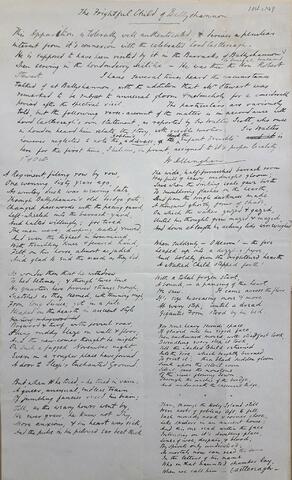Código de referencia
Título
Fecha(s)
- 1 Oct. 1849 (Creación)
Nivel de descripción
Volumen y soporte
1 p.; manuscript
Nombre del productor
Institución archivística
Historia archivística
Origen del ingreso o transferencia
Alcance y contenido
A poem by William Allingham titled ‘The Frightful Child of Ballyshannon’ and dated 1 October 1849. As noted in Allingham’s introduction, the poem refers to a story that a ghostly apparition (taking the form of a child) haunted Robert Stewart, better known as Lord Castlereagh (1769-1822), a leading Anglo-Irish statesman and politician, probably best remembered for his role in suppressing the 1798 Rebellion and in securing the passage of the Act of Union in 1800.
The verse recounts a local tradition that Stewart was visited by the spectre while inspecting a military barracks in Ballyshannon in County Donegal. Allingham suggests that Stewart was subject to an ‘unusual gloom and melancholy for a period after the spectral visit’. Stewart was known to be susceptible to paranoia and later severe mental health problems. It is likely that Allingham’s poem was also influenced by the fact that Stewart was a widely reviled figure in Ireland.
The last stanza of Allingham’s poem reads:
Then, through the Holy Island still
Were nests of goblins left, to fill
Each mouldy nook & corner close,
Like spiders in an ancient house:
And this one read within the face
Intruding on it’s dwelling-place,
Lines of woe, despair, & blood;
By Spirits only understood;
As mortals now can read the same
In the letters of his name
Who in that haunted chamber lay,
When we call him — Castlereagh.
Valorización, destrucción y programación
Acumulaciones
Sistema de arreglo
Condiciones de acceso
Condiciones
Idioma del material
Escritura del material
Notas sobre las lenguas y escrituras
Características físicas y requisitos técnicos
Instrumentos de descripción
Existencia y localización de originales
Existencia y localización de copias
Unidades de descripción relacionadas
Notas
For biographical information on William Allingham (1824-1889) see https://www.dib.ie/biography/allingham-william-a0122

